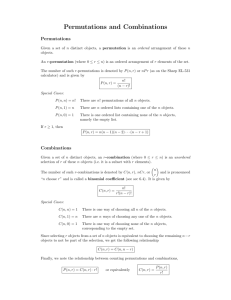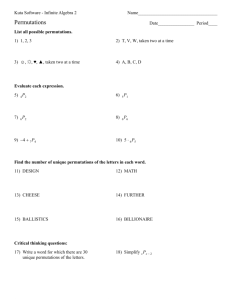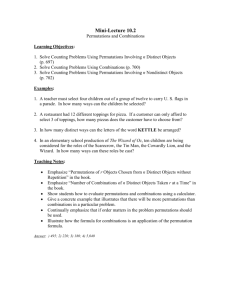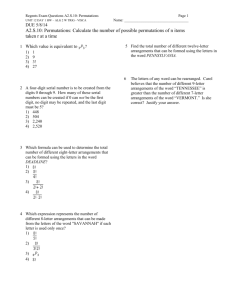Intersecting Families of Permutations
advertisement
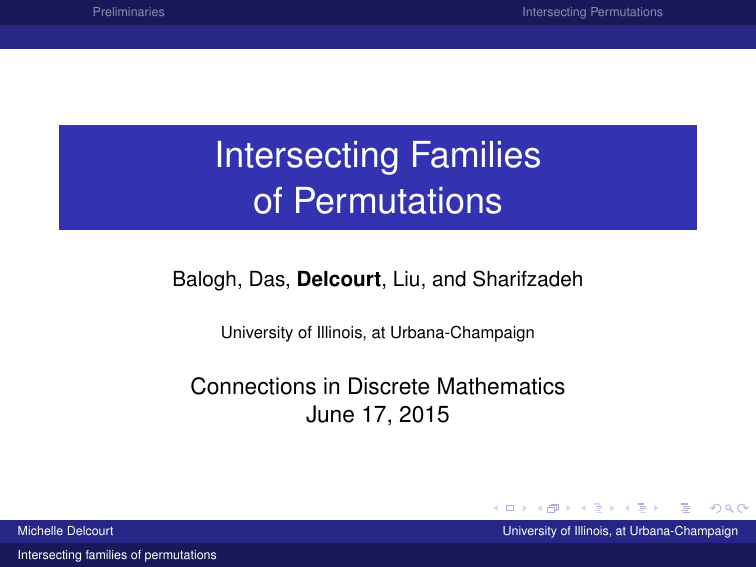
Preliminaries
Intersecting Permutations
Intersecting Families
of Permutations
Balogh, Das, Delcourt, Liu, and Sharifzadeh
University of Illinois, at Urbana-Champaign
Connections in Discrete Mathematics
June 17, 2015
Michelle Delcourt
Intersecting families of permutations
University of Illinois, at Urbana-Champaign
Preliminaries
Intersecting Permutations
1. Preliminaries
Motivation
Definitions
Hypergraphs
Michelle Delcourt
Intersecting families of permutations
University of Illinois, at Urbana-Champaign
Preliminaries
Intersecting Permutations
Extremal Combinatorics
How large can a system be under certain restrictions?
Can we enumerate such systems?
Can we describe the “typical structure”?
Michelle Delcourt
Intersecting families of permutations
University of Illinois, at Urbana-Champaign
Preliminaries
Intersecting Permutations
Theorem (Mantel 1907)
The maximum
j 2 k number of edges in an n vertex triangle-free
graph is n4 .
Theorem (Erdős–Kleitman–Rothschild 1976)
There are at most 2(1+o(1))·ex(n,Kt ) Kt -free graphs on n vertices.
Sharp sparse analogue
Corollary (Balogh–Morris–Samotij–Warnke 2013+)
Almost every Kt -free n vertex graph with m > m(n) edges is
(t − 1)-partite, where m(n) is best possible.
Michelle Delcourt
Intersecting families of permutations
University of Illinois, at Urbana-Champaign
Preliminaries
Intersecting Permutations
Theorem (Mantel 1907)
The maximum
j 2 k number of edges in an n vertex triangle-free
graph is n4 .
Theorem (Erdős–Kleitman–Rothschild 1976)
There are at most 2(1+o(1))·ex(n,Kt ) Kt -free graphs on n vertices.
Sharp sparse analogue
Corollary (Balogh–Morris–Samotij–Warnke 2013+)
Almost every Kt -free n vertex graph with m > m(n) edges is
(t − 1)-partite, where m(n) is best possible.
Michelle Delcourt
Intersecting families of permutations
University of Illinois, at Urbana-Champaign
Preliminaries
Intersecting Permutations
Theorem (Mantel 1907)
The maximum
j 2 k number of edges in an n vertex triangle-free
graph is n4 .
Theorem (Erdős–Kleitman–Rothschild 1976)
There are at most 2(1+o(1))·ex(n,Kt ) Kt -free graphs on n vertices.
Sharp sparse analogue
Corollary (Balogh–Morris–Samotij–Warnke 2013+)
Almost every Kt -free n vertex graph with m > m(n) edges is
(t − 1)-partite, where m(n) is best possible.
Michelle Delcourt
Intersecting families of permutations
University of Illinois, at Urbana-Champaign
Preliminaries
Intersecting Permutations
1. Preliminaries
Motivation
Definitions
Hypergraphs
Michelle Delcourt
Intersecting families of permutations
University of Illinois, at Urbana-Champaign
Preliminaries
Intersecting Permutations
k -uniform hypergraph on [n], F ⊆
∀F , G ∈ E(F), |F ∩ G| ≥ 1
F⊆
[n]
k
[n]
k
is intersecting if
is trivial if each edge contains a fixed vertex
1
Michelle Delcourt
Intersecting families of permutations
University of Illinois, at Urbana-Champaign
Preliminaries
Intersecting Permutations
k -uniform hypergraph on [n], F ⊆
∀F , G ∈ E(F), |F ∩ G| ≥ 1
F⊆
[n]
k
[n]
k
is intersecting if
is trivial if each edge contains a fixed vertex
1
Michelle Delcourt
Intersecting families of permutations
University of Illinois, at Urbana-Champaign
Preliminaries
Intersecting Permutations
k -uniform hypergraph on [n], F ⊆
∀F , G ∈ E(F), |F ∩ G| ≥ 1
F⊆
[n]
k
[n]
k
is intersecting if
is trivial if each edge contains a fixed vertex
1
Michelle Delcourt
Intersecting families of permutations
University of Illinois, at Urbana-Champaign
Preliminaries
Intersecting Permutations
How large can an intersecting family be?
Theorem (Erdős–Ko–Rado 1961)
If n ≥ 2k and F ⊆ [n]
k is intersecting, then
n−1
e(F) ≤
.
k −1
For n > 2k we have equality only if F is trivial.
Michelle Delcourt
Intersecting families of permutations
University of Illinois, at Urbana-Champaign
Preliminaries
Intersecting Permutations
1. Preliminaries
Motivation
Definitions
Hypergraphs
Michelle Delcourt
Intersecting families of permutations
University of Illinois, at Urbana-Champaign
Preliminaries
Intersecting Permutations
Let Hk (n, p) be the k -uniform hypergraph on [n] with each
edge included independently with probability p
Let i(H) := max {e(F) : F ⊆ H, F intersecting}
Theorem (Erdős–Ko–Rado Restated)
If n ≥ 2k , then
[n]
n−1
i H (n, 1) = i
≤
.
k
k −1
k
For n > 2k equality is achieved only by a trivial subhypergraph.
Michelle Delcourt
Intersecting families of permutations
University of Illinois, at Urbana-Champaign
Preliminaries
Intersecting Permutations
Let Hk (n, p) be the k -uniform hypergraph on [n] with each
edge included independently with probability p
Let i(H) := max {e(F) : F ⊆ H, F intersecting}
Theorem (Erdős–Ko–Rado Restated)
If n ≥ 2k , then
[n]
n−1
i H (n, 1) = i
≤
.
k
k −1
k
For n > 2k equality is achieved only by a trivial subhypergraph.
Michelle Delcourt
Intersecting families of permutations
University of Illinois, at Urbana-Champaign
Preliminaries
Intersecting Permutations
Let Hk (n, p) be the k -uniform hypergraph on [n] with each
edge included independently with probability p
Let i(H) := max {e(F) : F ⊆ H, F intersecting}
Theorem (Erdős–Ko–Rado Restated)
If n ≥ 2k , then
[n]
n−1
i H (n, 1) = i
≤
.
k
k −1
k
For n > 2k equality is achieved only by a trivial subhypergraph.
Michelle Delcourt
Intersecting families of permutations
University of Illinois, at Urbana-Champaign
Preliminaries
Intersecting Permutations
H satisfies Erdős-Ko-Rado if i(H) is achieved only by a trivial
subhypergraph
Question (Balogh–Bohman–Mubayi 2009)
Given 2 ≤ k < n/2, for which functions p = p(n) ∈ [0, 1] does
Hk (n, p) satisfy Erdős-Ko-Rado?
Balogh–Bohman–Mubayi settled this for k < n1/2−o(1)
Michelle Delcourt
Intersecting families of permutations
University of Illinois, at Urbana-Champaign
Preliminaries
Intersecting Permutations
H satisfies Erdős-Ko-Rado if i(H) is achieved only by a trivial
subhypergraph
Question (Balogh–Bohman–Mubayi 2009)
Given 2 ≤ k < n/2, for which functions p = p(n) ∈ [0, 1] does
Hk (n, p) satisfy Erdős-Ko-Rado?
Balogh–Bohman–Mubayi settled this for k < n1/2−o(1)
Michelle Delcourt
Intersecting families of permutations
University of Illinois, at Urbana-Champaign
Preliminaries
Intersecting Permutations
H satisfies Erdős-Ko-Rado if i(H) is achieved only by a trivial
subhypergraph
Question (Balogh–Bohman–Mubayi 2009)
Given 2 ≤ k < n/2, for which functions p = p(n) ∈ [0, 1] does
Hk (n, p) satisfy Erdős-Ko-Rado?
Balogh–Bohman–Mubayi settled this for k < n1/2−o(1)
Michelle Delcourt
Intersecting families of permutations
University of Illinois, at Urbana-Champaign
Preliminaries
Intersecting Permutations
Theorem (Gauy–Hàn–Oliveira 2014+)
Let δ = δ(n) > 0. If ln n k <
almost surely as n → ∞
(1−δ)n
2
and p 1δ ( lnkn )1/2 , then
n−1
i(H (n, p)) = (1 + o(1))p
.
k −1
k
Trivial intersecting subfamilies are asymptotically largest
Michelle Delcourt
Intersecting families of permutations
University of Illinois, at Urbana-Champaign
Preliminaries
Intersecting Permutations
Things change around k =
√
n.
For smaller k , two random k -sets are typically disjoint
For larger k , the opposite holds
Result (Hamm–Kahn 2014+)
For any fixed c < 1/4, and
k<
p
cn log n
characterize p = p(n, k ) for which then Hk (n, p) satisfies
Erdős–Ko–Rado w.h.p.
Michelle Delcourt
Intersecting families of permutations
University of Illinois, at Urbana-Champaign
Preliminaries
Intersecting Permutations
Things change around k =
√
n.
For smaller k , two random k -sets are typically disjoint
For larger k , the opposite holds
Result (Hamm–Kahn 2014+)
For any fixed c < 1/4, and
k<
p
cn log n
characterize p = p(n, k ) for which then Hk (n, p) satisfies
Erdős–Ko–Rado w.h.p.
Michelle Delcourt
Intersecting families of permutations
University of Illinois, at Urbana-Champaign
Preliminaries
Intersecting Permutations
Theorem (Hamm–Kahn 2014+)
There is a fixed ε > 0 such that the following holds.
If n = 2k + 1 and p > 1 − ε, then Hk (n, p) satisfies
Erdős–Ko–Rado w.h.p.
Theorem (Balogh–Das–D.–Liu–Sharifzadeh 2015)
For 3 ≤ k ≤ n4 , if
p = p(n) ≥ c · n log
ne k
2k n
k
k
n−k 2
k
,
then w.h.p. every largest intersecting subhypergraph of
Hk (n, p) is trivial.
Michelle Delcourt
Intersecting families of permutations
University of Illinois, at Urbana-Champaign
Preliminaries
Intersecting Permutations
Theorem (Hamm–Kahn 2014+)
There is a fixed ε > 0 such that the following holds.
If n = 2k + 1 and p > 1 − ε, then Hk (n, p) satisfies
Erdős–Ko–Rado w.h.p.
Theorem (Balogh–Das–D.–Liu–Sharifzadeh 2015)
For 3 ≤ k ≤ n4 , if
p = p(n) ≥ c · n log
ne k
2k n
k
k
n−k 2
k
,
then w.h.p. every largest intersecting subhypergraph of
Hk (n, p) is trivial.
Michelle Delcourt
Intersecting families of permutations
University of Illinois, at Urbana-Champaign
Preliminaries
Intersecting Permutations
2. Intersecting Permutations
Background
Main Result
Michelle Delcourt
Intersecting families of permutations
University of Illinois, at Urbana-Champaign
Preliminaries
Intersecting Permutations
Let Sn denote the symmetric group on [n]
F ⊆ Sn is intersecting if ∀ σ, π ∈ F
|σ ∩ π| := |{i ∈ [n] : σ(i) = π(i)}| ≥ 1
For example,
1 2 3 4
1 3 4 2
2 3 1 4
Michelle Delcourt
Intersecting families of permutations
University of Illinois, at Urbana-Champaign
Preliminaries
Intersecting Permutations
Let Sn denote the symmetric group on [n]
F ⊆ Sn is intersecting if ∀ σ, π ∈ F
|σ ∩ π| := |{i ∈ [n] : σ(i) = π(i)}| ≥ 1
For example,
1 2 3 4
1 3 4 2
2 3 1 4
Michelle Delcourt
Intersecting families of permutations
University of Illinois, at Urbana-Champaign
Preliminaries
Intersecting Permutations
Let Sn denote the symmetric group on [n]
F ⊆ Sn is intersecting if ∀ σ, π ∈ F
|σ ∩ π| := |{i ∈ [n] : σ(i) = π(i)}| ≥ 1
For example,
1 2 3 4
1 3 4 2
2 3 1 4
Michelle Delcourt
Intersecting families of permutations
University of Illinois, at Urbana-Champaign
Preliminaries
Intersecting Permutations
Let Sn denote the symmetric group on [n]
F ⊆ Sn is intersecting if ∀ σ, π ∈ F
|σ ∩ π| := |{i ∈ [n] : σ(i) = π(i)}| ≥ 1
For example,
1 2 3 4
1 3 4 2
2 3 1 4
Michelle Delcourt
Intersecting families of permutations
University of Illinois, at Urbana-Champaign
Preliminaries
Intersecting Permutations
Let Sn denote the symmetric group on [n]
F ⊆ Sn is intersecting if ∀ σ, π ∈ F
|σ ∩ π| := |{i ∈ [n] : σ(i) = π(i)}| ≥ 1
For example,
1 2 3 4
1 3 4 2
2 3 1 4
Michelle Delcourt
Intersecting families of permutations
University of Illinois, at Urbana-Champaign
Preliminaries
Intersecting Permutations
Let Sn denote the symmetric group on [n]
F ⊆ Sn is intersecting if ∀ σ, π ∈ F
|σ ∩ π| := |{i ∈ [n] : σ(i) = π(i)}| ≥ 1
F ⊆ Sn is trivial if ∃ i, j ∈ [n] such that π(i) = j ∀ π ∈ F
For example,
1 2 3 4
1 2 4 3
1 3 2 4
1 3 4 2
1 4 2 3
1 4 3 2
Michelle Delcourt
Intersecting families of permutations
University of Illinois, at Urbana-Champaign
Preliminaries
Intersecting Permutations
Let Sn denote the symmetric group on [n]
F ⊆ Sn is intersecting if ∀ σ, π ∈ F
|σ ∩ π| := |{i ∈ [n] : σ(i) = π(i)}| ≥ 1
F ⊆ Sn is trivial if ∃ i, j ∈ [n] such that π(i) = j ∀ π ∈ F
For example,
1 2 3 4
1 2 4 3
1 3 2 4
1 3 4 2
1 4 2 3
1 4 3 2
Michelle Delcourt
Intersecting families of permutations
University of Illinois, at Urbana-Champaign
Preliminaries
Intersecting Permutations
Let Sn denote the symmetric group on [n]
F ⊆ Sn is intersecting if ∀ σ, π ∈ F
|σ ∩ π| := |{i ∈ [n] : σ(i) = π(i)}| ≥ 1
F ⊆ Sn is trivial if ∃ i, j ∈ [n] such that π(i) = j ∀ π ∈ F
For example,
1 2 3 4
1 2 4 3
1 3 2 4
1 3 4 2
1 4 2 3
1 4 3 2
Michelle Delcourt
Intersecting families of permutations
University of Illinois, at Urbana-Champaign
Preliminaries
Intersecting Permutations
How large can an intersecting family be?
1
1
1
1
1
1
2
2
3
3
4
4
3
4
2
4
2
3
4
3
4
2
3
2
for fixed i, j ∈ [n],
|{σ ∈ Sn : σ(i) = j}| = (n − 1)!
(4 − 1)! = 3! = 6
Theorem (Frankl–Deza 1977)
If F ⊆ Sn is intersecting, then |F| ≤ (n − 1)!.
Theorem (Cameron–Ku / Larose–Malvenuto 2003)
We have equality above only if F ⊆ Sn is trivial.
Michelle Delcourt
Intersecting families of permutations
University of Illinois, at Urbana-Champaign
Preliminaries
Intersecting Permutations
How large can an intersecting family be?
1
1
1
1
1
1
2
2
3
3
4
4
3
4
2
4
2
3
4
3
4
2
3
2
for fixed i, j ∈ [n],
|{σ ∈ Sn : σ(i) = j}| = (n − 1)!
(4 − 1)! = 3! = 6
Theorem (Frankl–Deza 1977)
If F ⊆ Sn is intersecting, then |F| ≤ (n − 1)!.
Theorem (Cameron–Ku / Larose–Malvenuto 2003)
We have equality above only if F ⊆ Sn is trivial.
Michelle Delcourt
Intersecting families of permutations
University of Illinois, at Urbana-Champaign
Preliminaries
Intersecting Permutations
How large can a non-trivial, intersecting family be?
Theorem (Ellis 2008)
For n sufficiently large, the largest non-trivial intersecting
F ⊆ Sn have size
1
1 − + o(1) (n − 1)!.
e
{σ ∈ Sn : σ(1) = 1, σ(j) = j for some j > 2} ∪ {(1 2)}
Michelle Delcourt
Intersecting families of permutations
University of Illinois, at Urbana-Champaign
Preliminaries
Intersecting Permutations
How large can a non-trivial, intersecting family be?
Theorem (Ellis 2008)
For n sufficiently large, the largest non-trivial intersecting
F ⊆ Sn have size
1
1 − + o(1) (n − 1)!.
e
{σ ∈ Sn : σ(1) = 1, σ(j) = j for some j > 2} ∪ {(1 2)}
Michelle Delcourt
Intersecting families of permutations
University of Illinois, at Urbana-Champaign
Preliminaries
Intersecting Permutations
How large can a non-trivial, intersecting family be?
Theorem (Ellis 2008)
For n sufficiently large, the largest non-trivial intersecting
F ⊆ Sn have size
1
1 − + o(1) (n − 1)!.
e
{σ ∈ Sn : σ(1) = 1, σ(j) = j for some j > 2} ∪ {(1 2)}
Michelle Delcourt
Intersecting families of permutations
University of Illinois, at Urbana-Champaign
Preliminaries
Intersecting Permutations
2. Intersecting Permutations
Background
Main Result
Michelle Delcourt
Intersecting families of permutations
University of Illinois, at Urbana-Champaign
Preliminaries
Intersecting Permutations
Theorem (Balogh–Das–D.–Liu–Sharifzadeh 2015)
1
The number of intersecting families of permutations is
(n2 + o(1))2(n−1)! .
2
Almost every intersecting family of permutations is trivial.
Michelle Delcourt
Intersecting families of permutations
University of Illinois, at Urbana-Champaign
Preliminaries
Intersecting Permutations
We will use the skew-symmetric Bollobás set-pairs inequality
Theorem (Frankl 1982)
Let A1 , . . . , Am be sets of size a and B1 , . . . , Bm be sets of size
b such that Ai ∩ Bi = ∅ and Ai ∩ Bj 6= ∅ for every 1 ≤ i < j ≤ m.
Then m ≤ a+b
a .
Michelle Delcourt
Intersecting families of permutations
University of Illinois, at Urbana-Champaign
Preliminaries
Intersecting Permutations
Proposition (Balogh–Das–D.–Liu–Sharifzadeh 2015)
The number of maximal intersecting families in Sn is at most
1 2n
2 n
( ) X
n!
i=0
i
2n
< nn2 .
Proof.
Pick F max int, I(F) := {π ∈ Sn : ∀σ ∈ F, |π ∩ σ| ≥ 1}
Let F 0 = {σ1 , . . . , σs } ⊂ F be a minimal generating set
(F = I(F 0 ))
∀i ∈ [s], ∃τi ∈ Sn such that |σj ∩ τi | = 0 iff i = j
Assign Hπ = {(1, π(1)), . . . , (n, π(n))}
Michelle Delcourt
Intersecting families of permutations
University of Illinois, at Urbana-Champaign
Preliminaries
Intersecting Permutations
Proposition (Balogh–Das–D.–Liu–Sharifzadeh 2015)
The number of maximal intersecting families in Sn is at most
1 2n
2 n
( ) X
n!
i=0
i
2n
< nn2 .
Proof.
Pick F max int, I(F) := {π ∈ Sn : ∀σ ∈ F, |π ∩ σ| ≥ 1}
Let F 0 = {σ1 , . . . , σs } ⊂ F be a minimal generating set
(F = I(F 0 ))
∀i ∈ [s], ∃τi ∈ Sn such that |σj ∩ τi | = 0 iff i = j
Assign Hπ = {(1, π(1)), . . . , (n, π(n))}
Michelle Delcourt
Intersecting families of permutations
University of Illinois, at Urbana-Champaign
Preliminaries
Intersecting Permutations
Proposition (Balogh–Das–D.–Liu–Sharifzadeh 2015)
The number of maximal intersecting families in Sn is at most
1 2n
2 n
( ) X
n!
i=0
i
2n
< nn2 .
Proof.
Pick F max int, I(F) := {π ∈ Sn : ∀σ ∈ F, |π ∩ σ| ≥ 1}
Let F 0 = {σ1 , . . . , σs } ⊂ F be a minimal generating set
(F = I(F 0 ))
∀i ∈ [s], ∃τi ∈ Sn such that |σj ∩ τi | = 0 iff i = j
Assign Hπ = {(1, π(1)), . . . , (n, π(n))}
Michelle Delcourt
Intersecting families of permutations
University of Illinois, at Urbana-Champaign
Preliminaries
Intersecting Permutations
Proposition (Balogh–Das–D.–Liu–Sharifzadeh 2015)
The number of maximal intersecting families in Sn is at most
1 2n
2 n
( ) X
n!
i=0
i
2n
< nn2 .
Proof.
Pick F max int, I(F) := {π ∈ Sn : ∀σ ∈ F, |π ∩ σ| ≥ 1}
Let F 0 = {σ1 , . . . , σs } ⊂ F be a minimal generating set
(F = I(F 0 ))
∀i ∈ [s], ∃τi ∈ Sn such that |σj ∩ τi | = 0 iff i = j
Assign Hπ = {(1, π(1)), . . . , (n, π(n))}
Michelle Delcourt
Intersecting families of permutations
University of Illinois, at Urbana-Champaign
Preliminaries
Intersecting Permutations
Proposition (Balogh–Das–D.–Liu–Sharifzadeh 2015)
The number of maximal intersecting families in Sn is at most
1 2n
2 n
( ) X
n!
i=0
i
2n
< nn2 .
Proof.
∀π, π 0 ∈ Sn , |Hπ ∩ Hπ0 | = |π ∩ π 0 |
Apply the Bollobás set-pairs inequality
for 1 ≤ i ≤ s, Ai = Hσi and Bi = Hτi , and
for s + 1 ≤ i ≤ 2s, Ai = Hτi−s and Bi = Hσi−s
Then s ≤ 21 2n
n
Michelle Delcourt
Intersecting families of permutations
University of Illinois, at Urbana-Champaign
Preliminaries
Intersecting Permutations
Proposition (Balogh–Das–D.–Liu–Sharifzadeh 2015)
The number of maximal intersecting families in Sn is at most
1 2n
2 n
( ) X
n!
i=0
i
2n
< nn2 .
Proof.
∀π, π 0 ∈ Sn , |Hπ ∩ Hπ0 | = |π ∩ π 0 |
Apply the Bollobás set-pairs inequality
for 1 ≤ i ≤ s, Ai = Hσi and Bi = Hτi , and
for s + 1 ≤ i ≤ 2s, Ai = Hτi−s and Bi = Hσi−s
Then s ≤ 21 2n
n
Michelle Delcourt
Intersecting families of permutations
University of Illinois, at Urbana-Champaign
Preliminaries
Intersecting Permutations
Proposition (Balogh–Das–D.–Liu–Sharifzadeh 2015)
The number of maximal intersecting families in Sn is at most
1 2n
2 n
( ) X
n!
i=0
i
2n
< nn2 .
Proof.
∀π, π 0 ∈ Sn , |Hπ ∩ Hπ0 | = |π ∩ π 0 |
Apply the Bollobás set-pairs inequality
for 1 ≤ i ≤ s, Ai = Hσi and Bi = Hτi , and
for s + 1 ≤ i ≤ 2s, Ai = Hτi−s and Bi = Hσi−s
Then s ≤ 21 2n
n
Michelle Delcourt
Intersecting families of permutations
University of Illinois, at Urbana-Champaign
Preliminaries
Intersecting Permutations
Proposition (Balogh–Das–D.–Liu–Sharifzadeh 2015)
The number of maximal intersecting families in Sn is at most
1 2n
2 n
( ) X
n!
i=0
i
2n
< nn2 .
Proof.
To every maximal family F we mayassign a distinct
generating set of size at most 21 2n
n
2n
The upper bound follows since n! ≤ nn and 2n
n ≤2
Michelle Delcourt
Intersecting families of permutations
University of Illinois, at Urbana-Champaign
Preliminaries
Intersecting Permutations
The general method
N0 size of a largest trivial intersecting family
N1 size of a largest non-trivial intersecting family
M upper bound on the number of maximal families
Observation
Any subset of a trivial intersecting family is itself trivial.
There are at least 2N0 trivial families
Observation
Any non-trivial intersecting family must be contained inside a
maximal non-trivial intersecting family.
There are at most M2N1 non-trivial families
M2N1
→0
2N0
Michelle Delcourt
Intersecting families of permutations
University of Illinois, at Urbana-Champaign
Preliminaries
Intersecting Permutations
The general method
N0 size of a largest trivial intersecting family
N1 size of a largest non-trivial intersecting family
M upper bound on the number of maximal families
Observation
Any subset of a trivial intersecting family is itself trivial.
There are at least 2N0 trivial families
Observation
Any non-trivial intersecting family must be contained inside a
maximal non-trivial intersecting family.
There are at most M2N1 non-trivial families
M2N1
→0
2N0
Michelle Delcourt
Intersecting families of permutations
University of Illinois, at Urbana-Champaign
Preliminaries
Intersecting Permutations
The general method
N0 size of a largest trivial intersecting family
N1 size of a largest non-trivial intersecting family
M upper bound on the number of maximal families
Observation
Any subset of a trivial intersecting family is itself trivial.
There are at least 2N0 trivial families
Observation
Any non-trivial intersecting family must be contained inside a
maximal non-trivial intersecting family.
There are at most M2N1 non-trivial families
M2N1
→0
2N0
Michelle Delcourt
Intersecting families of permutations
University of Illinois, at Urbana-Champaign
Preliminaries
Intersecting Permutations
The general method
N0 size of a largest trivial intersecting family
N1 size of a largest non-trivial intersecting family
M upper bound on the number of maximal families
Observation
Any subset of a trivial intersecting family is itself trivial.
There are at least 2N0 trivial families
Observation
Any non-trivial intersecting family must be contained inside a
maximal non-trivial intersecting family.
There are at most M2N1 non-trivial families
M2N1
→0
2N0
Michelle Delcourt
Intersecting families of permutations
University of Illinois, at Urbana-Champaign
Preliminaries
Intersecting Permutations
Thank you for listening!
Michelle Delcourt
Intersecting families of permutations
University of Illinois, at Urbana-Champaign




